mobile View, to the German Version tap the flag


- Republic of Albania
- presidial republic
- own name: Republika Shquipërisë
• Flags
• Historical Flags
• Meaning/Origin of the Flag
• Coat of Arms
• Historical Coats of Arms
• Meaning/Origin of the Coat of Arms
• Aircraft Roundel
• Map
• Numbers and Facts
• History
• Origin of the Country's Name
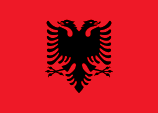
since 1992,
National flag,
ratio = 5:7,
Source, by: Wikipedia (D)





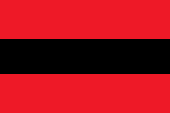
Merchant flag,
ratio = 2:3,
Source, by: Flags of all Nations



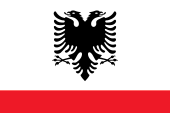
Naval flag,
ratio = 2:3,
Source, by: Flags of all Nations



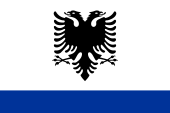
Flag of aux ships (Official flag at sea),
ratio = 2:3,
Source, by: Wikipedia (D)



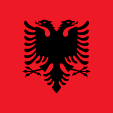
Flag of the president,
ratio = 1:1,
Source, by: Wikipedia (D)




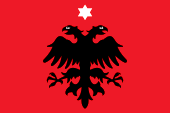
1912–1913,
Republic of Albania,
National flag,
Source, by: Flags of the World



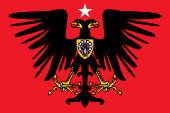
1914,
Principality of Albania,
National flag,
Source, by: Flags of the World



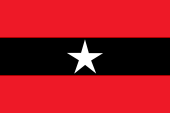
1914,
Principality of Albania,
Merchant flag,
Source, by: Flags of the World



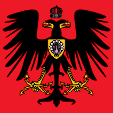
1914,
Principality of Albania,
Standard of William Prince of Wied, Prince of Albania,
Source, by: Flags of the World



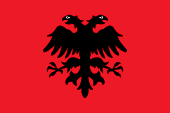
1914–1920,
Republic of Albania,
National flag,
ratio = 2:3,
Source, by: Flags of the World



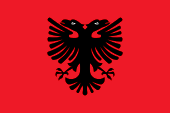
1920–1928,
Republic of Albania,
National-, naval und war flag,
ratio = 2:3,
Source, by: Flags of the World




1920–1928,
Republic of Albania,
Merchant flag,
ratio = 2:3,
Source, by: Flags of the World



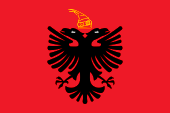
1920–1928,
Republic of Albania,
Flag of the president,
ratio = 2:3,
Source, by: Flags of the World



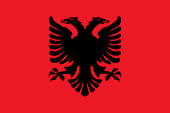
1928–1939,
Kingdom of Albania,
National flag,
ratio = 2:3,
Source, by: Flags of the World



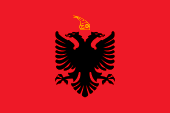
1928–1939,
Kingdom of Albania,
State flag,
ratio = 2:3,
Source, by: Flags of the World




1928–1939,
Kingdom of Albania,
Merchant flag,
ratio = 2:3,
Source, by: Flags of the World



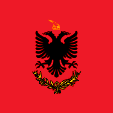
1928–1939,
Kingdom of Albania,
Flag of the king,
ratio = 1:1,
Source, by: Flags of the World



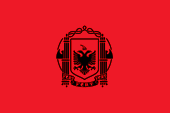
1939–1943,
Kingdom of Albania,
National flag,
ratio = 2:3,
Source, by:
Flags of the World,
F l a n k e r, Public domain, via Wikimedia Commons



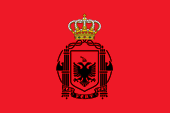
1939–1943,
Kingdom of Albania,
State flag,
ratio = 2:3,
Source, by:
Flags of the World,
F l a n k e r, Public domain, via Wikimedia Commons



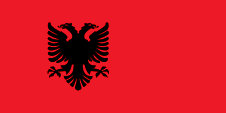
1943–1944,
National flag,
ratio = 1:2,
Source, by: Flags of the World



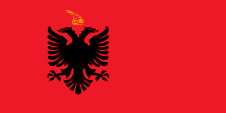
1943–1944,
State flag,
ratio = 1:2,
Source, by: Flags of the World



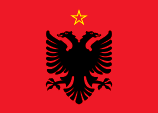
1946–1992,
Socialist People's Republic of Albania,
National flag,
ratio = 5:7,
Source, by: Flags of the World



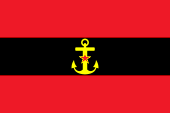
1946–1954,
Socialist People's Republic of Albania,
Naval flag,
ratio = 2:3,
Source, by: Flags of the World



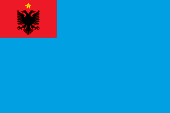
1954-1958,
Socialist People's Republic of Albania,
Naval flag,
ratio = 2:3,
Source, by: Flags of the World



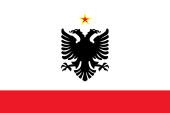
1958–1992,
Socialist People's Republic of Albania,
Naval flag,
ratio = 2:3,
Source, by: Flags of the World



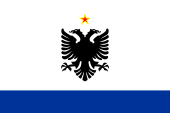
1958–1992,
Socialist People's Republic of Albania,
Flagge der Hilfsschiffe,
ratio = 2:3,
Source, by: Flags of the World



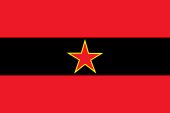
1946–1992,
Socialist People's Republic of Albania,
Merchant flag,
ratio = 2:3,
Source, by: Flags of the World



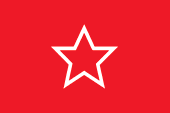
1958–1992,
Socialist People's Republic of Albania,
Naval jack,
ratio = 2:3,
Source, by: Flags of the World



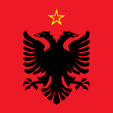
1946–1992,
Socialist People's Republic of Albania,
Flagge des Präsidenten,
ratio = 1:1,
Source, by: Flags of the World




The flag of Albania goes directly back to the national hero Skanderbeg. He was of origin, and was named really George Kastriota. He led an anti-Turkish revolt between the years 1443 and 1468, after the ever further expanding Ottoman Empire since 1385 had wrestled down Epirus, the remaining rump territory of Byzantium, the Empire began to subdue the territory of today's Albania. During the revolt Skanderbeg used red flags with a black double-headed eagle. He was probably Skanderbeg inspired by the Byzantine flag. Ostensibly, the legend that the Albanians are descendants of eagles, might also have played a role.
After the declaration of independence from the Ottoman Empire on the 28th of November, 1912, they remember the old flag, and introduced a red flag, with a black two-headed eagle and a six-pointed star above. The star was to be a reminder for Albanians, that they have the same firmament above their heads regardless to which religion they may belong. When the German Prince Wilhelm zu Wied became Prince of Albania, the flag was changed a little, because a part of the old Epirus now belonged to Albania, the four golden lightning bolts in the claws of the eagle representing Epirus were incorporated. When on the 1st of September, 1928 Ahmed Zogu became Albanian King, he caused a changing of the flag: the golden helmet of Skanderbeg was placed on the state flag. When Italy occupied in 1939 Albania, the flag of Albania was changed again: The Albanian crown was added to the eagle and two bundles of black Fasces (the Roman symbol for the authority of the Lictors).
Likewise, the anti-Italian resistance, under communist leadership, used the red flag with the eagle, with a yellow five-pointed star above its heads. This flag was officially introduced on the 15th of March, 1946 in connexion with the founding of the people's republic. With the resignation of the last communist president the star was deleted from the flag on the 7th of April, 1992.
Source:
Die Welt der Flaggen,
Flaggen und Wappen der Welt
Translator of the English text: Joachim Nuthack


since 1993,
Coat of arms of Albania,
Source, by:
Wikipedia (D), Government of Albania, Public domain, via Wikimedia Commons

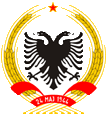
1946–1992,
Coat of arms of Albania,
Source, by:
Flaggen und Wappen der Welt
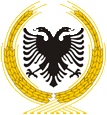
1992–1993,
Coat of arms of Albania,
Source, by:
Flaggen und Wappen der Welt

In connexion with the founding of the people's republic (1946) different coat of arms was also introduced. The eagle was surrounded by ears of grain, and above the eagle was placed, as on the flag, a red yellow-bordered five-pointed star. The ears of grain were bound with a red ribbon, which contained the date 24th of May, 1944. On this date a so-called "anti-faschist liberation committee" was formed in Permeti. On the 7th of April, 1992 the ribbon with the date and the star was initially removed, however, since the 22nd of May, 1993 the black twin-headed eagle in a red shield was in use. Since 2004 appears above the eagle the golden helmet of Skanderbeg.
Source:
Flaggen und Wappen der Welt, Translator of the English text: Joachim Nuthack

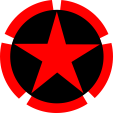
1962–1992,
Aircraft Roundel,
Source, by: Wikipedia (EN)

since 1992,
Aircraft Roundel,
Source, by: Wikipedia (EN)

Location:
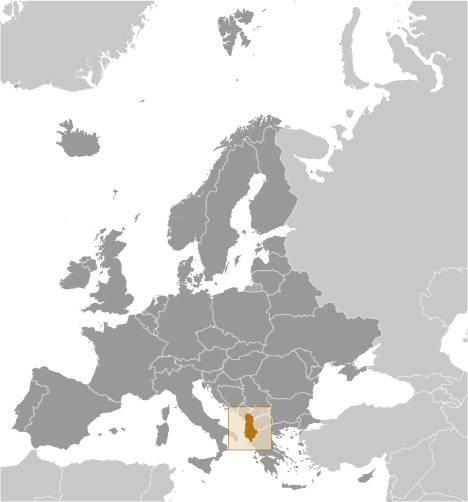
Source: CIA World Factbook
Map of the country:
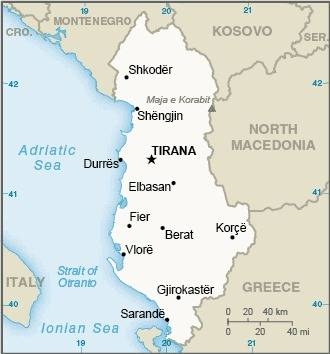
Source: CIA World Factbook

Area: 11.099 square miles
Inhabitants: 3.074.580 (2020), thereof 83% Albanians, 2% Greeks
Religions: 56% Muslim, 10% Catholic Christian, 7% Albanian Orthodox Christian
Density of Population: 277 inh./sq.mi.
Capital: Tirana, 418.500 inh. (2011)
official Language: Albanian
other Languages: Macedonian, Greek, Italian
Currency: Lek (ALL)
Time Zone: GMT + 1 h
Source: Wikipedia (D)

380 B.C. to 168 B.C. · Empire of the Illyrian Labeates
395 A.D. · when the Roman Empire is divided, today's Albania comes to the Eastern Roman Empire (Byzantium)
591 · Slav invasion
880–1018 · central and southern Albania are part of the Bulgarian Empire
1081 · Norman Invasion
1204–1430 · from the end of the 4th Crusade (collapse of the Byzantine Empire), parts of the country come to Naples, Serbia and Venice and local Albanian principalities emerge (Kruja, Thopias, Balscha)
1430 · Attacks by the Turks
1443–1468 · Prince Georg Kastriota Skanderbeg's successful defensive battle against the Turks
1479 · the country becomes part of the Ottoman Empire
1910 · Anti-Turkish uprising, only the big cities are under control of the Ottoman Empire
28th of November 1912 · independence as the Republic of Albania
21st of February in 1914 · the leaders of the often divided Albanian ethnic and religious groups offer Wilhelm Prinz zu Wied in Neuwied (Rhineland) the Albanian crown, he becomes Prince Wilhelm I. of Albania, the great powers promise support
March to August 1914 · Wilhelm I. comes under pressure from revolts by the Greeks, Muslims and local rulers, the great powers do not provide any support
3rd of September 1914 · Wilhelm I. emigrates to Romania, but never abdicates, the country is occupied by foreign powers during the First World War, the nominal republic of Albania continues to exist, Italy, Serbia and Greece occupy and claim parts of the country for themselves until 1920
1917 · Wilhelm I. demands his reinstatement
1919 · negotiations on the division of the land
January 1920 · Albanian Congress of Lushnja, deposition of the government of Turhan Pascha, new election of a government under Sulejman Delvina, which is quickly recognized internationally, the occupying powers withdraw
December 1920 · joining to the League of Nations
1925 · authoritarian reign of Ahmet Zogu
1928 · Ahmet Zogu proclaims himself king, the now Kingdom of Albania becomes increasingly dependent from Italy in the following years
1939 · Second World War, Italy occupies the country, Victor Emanuel, King of Italy, is installed as King of Albania in personal union, Ahmet Zogu flees, in the following years establishes and increases a by communists dominated resistance
8th of September in 1943 · Italy surrenders, German troops occupy the country
24th of May in 1944 · Congress of Përmet, formation of a provisional communist government
29th of November in 1944 · the German troops leave the country
11th of January in 1946 · proclamation of the People's Republic of Albania
14th of May in 1955 · joining to the Warsaw Pact (left in 1968)
14th of December in 1955 · joining to the United Nations (UN)
28th of December in 1976 · new constitution, rename in Socialist People's Republic of Albania
Fall 1990 · anti-communist movement
31st of March in 1991 · elections, the communist government is confirmed
4th of June in 1991 · general strike, resignation of the communist government, formation of a government of national unity, rename in Republic of Albania
9th of July in 2009 · joining to the NATO
Source: Atlas zur Geschichte,
Wikipedia (D),
Länder der Erde

The name Albania has its roots in the Indogerman word "alb" → "high, or mountain", which later had been merged with the meaning of the Latin word "albus" → "white". Albania is the "Highlands". The Albanians (native name: Shiptar) call their country "Shiperija" or "Shiptarije.
Source: Handbuch der geographischen Namen


![]()
































































































